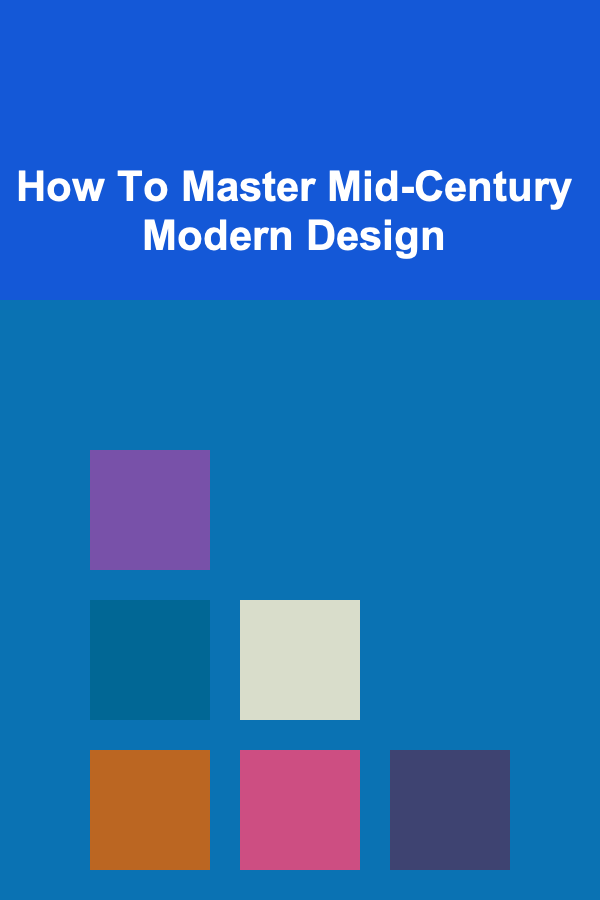
How To Master Mid-Century Modern Design
ebook include PDF & Audio bundle (Micro Guide)
$12.99$8.99
Limited Time Offer! Order within the next:

Mid-century modern design has stood the test of time, continuing to influence contemporary interiors and architecture. Emerging during the mid-20th century, this design style became synonymous with innovation, functionality, and a seamless blend of aesthetics and practicality. Mastering mid-century modern design involves more than just understanding its history and visual elements; it requires an appreciation for the philosophy that underpins it.
In this article, we will explore how to master mid-century modern design by diving into its origins, key principles, iconic elements, and how to incorporate it into your own space. Whether you're a design enthusiast or a professional, understanding the nuances of this timeless style will enhance your ability to create elegant and functional environments.
The Origins of Mid-Century Modern Design
Mid-century modern design is a product of the cultural and technological shifts that occurred after World War II. The world was undergoing rapid changes, with a burgeoning middle class, increased consumerism, and significant advancements in technology and materials. These shifts created an appetite for design that was not only aesthetically pleasing but also functional and accessible.
The term "mid-century modern" refers to a design style that primarily spans from the 1940s to the 1960s, although its influence continues to be seen today. It originated in Europe, drawing inspiration from the Bauhaus movement, which emphasized simplicity, clean lines, and the integration of art with industry. In the United States, the style was shaped by the post-war optimism, economic growth, and the widespread desire for innovation in everyday life.
Key designers, such as Charles and Ray Eames, George Nelson, and Eero Saarinen, were instrumental in shaping mid-century modern design. Their work embodied the principles of the style, focusing on creating functional yet beautiful pieces that could be mass-produced to make modern living more comfortable and accessible.
Key Principles of Mid-Century Modern Design
To master mid-century modern design, it's essential to understand its core principles. These principles guide not only the visual aesthetics but also the philosophy behind the design choices.
1. Simplicity and Functionality
At the heart of mid-century modern design is the belief that form should follow function. The design should be simple, clean, and without unnecessary ornamentation. Every piece of furniture or decor should serve a purpose and be built with efficiency in mind. This emphasis on simplicity led to streamlined shapes and the elimination of excessive detailing that was common in earlier design periods.
Incorporating this principle means choosing functional pieces that fit the needs of your space. Furniture with minimalist shapes, such as sleek lines and smooth surfaces, embodies this focus on utility without sacrificing style.
2. Clean Lines and Geometric Shapes
Mid-century modern design is known for its sharp, clean lines and geometric shapes. Unlike the ornate curves and detailing found in earlier design styles like Art Deco or Victorian, mid-century modern furniture often features straight lines and bold, angular forms. This gives the style a sense of precision and modernity.
Geometric shapes such as squares, rectangles, and triangles are common in mid-century modern decor. These shapes can be found in everything from furniture to architecture, wall art, and even textiles. Incorporating these elements into your design creates a sense of order and symmetry while maintaining a visually appealing space.
3. Embrace of New Materials
The mid-20th century was a time of technological and material innovation. As a result, mid-century modern design makes extensive use of new materials that were previously unavailable or underutilized. The introduction of plastics, plywood, fiberglass, and stainless steel revolutionized the way furniture was designed and manufactured.
For example, the Eames Lounge Chair, a quintessential mid-century modern piece, used molded plywood for its structure and leather for comfort. The use of these materials allowed for more ergonomic designs, and their affordability made it possible to mass-produce pieces for a broader audience. When mastering this style, be mindful of incorporating materials that are both functional and visually interesting.
4. Indoor-Outdoor Connection
Another defining feature of mid-century modern design is its connection to the outdoors. This style blurs the line between interior and exterior spaces, making natural light and outdoor elements integral to the overall design. Large windows, sliding glass doors, and open floor plans are typical of mid-century modern homes, allowing residents to enjoy the natural environment from the comfort of their home.
When incorporating mid-century modern elements into your space, prioritize natural light. Choose window treatments that allow for ample sunlight and consider furniture arrangements that take advantage of scenic views.
5. Bold, Yet Muted Color Palettes
While mid-century modern design embraced bold, bright colors, it was always done in a controlled and deliberate manner. The color palette for this style often features vibrant hues paired with neutral tones. For example, rich oranges, teal, mustard yellow, and avocado green are balanced with whites, browns, and blacks. This creates a visually appealing contrast that adds depth and energy to the space without overwhelming it.
In mastering mid-century modern design, consider using color to highlight specific areas of a room. A bold accent wall, a piece of statement furniture, or a colorful rug can create focal points while maintaining the overall balance of the space.
Iconic Mid-Century Modern Elements
Mastering mid-century modern design involves an understanding of the key elements that make this style so distinctive. These elements are not only functional but are also integral to creating the aesthetic that defines mid-century modern interiors.
1. Furniture
Mid-century modern furniture is known for its minimalist shapes and practical design. Chairs, tables, and couches from this era often feature clean lines, low profiles, and materials like wood, metal, and upholstery in bold fabrics. Key pieces include the Eames Lounge Chair, the Saarinen Tulip Table, and the Noguchi Coffee Table.
When incorporating mid-century modern furniture into your space, focus on pieces that embody the principles of simplicity, functionality, and sleek design. For example, a wooden coffee table with slender, angled legs and a minimalist design will immediately evoke the style.
2. Lighting
Lighting plays a crucial role in mid-century modern design, both in terms of function and aesthetics. Iconic lighting fixtures from this period include the Arco Floor Lamp, the Nelson Bubble Lamp, and the Sputnik chandelier. These designs are often geometric, sculptural, and made from innovative materials like molded plastic and metal.
To master mid-century modern lighting, opt for fixtures that are statement pieces themselves. A bold pendant light or sculptural floor lamp can act as both a functional light source and a focal point in your space.
3. Art and Decor
Mid-century modern decor includes wall art, textiles, and accessories that complement the clean lines and minimalistic style. Abstract art, geometric patterns, and pop art were especially popular during this time. Additionally, mid-century modern spaces often feature retro-inspired accessories such as clocks, vases, and ceramic sculptures.
When adding art and decor, focus on pieces that have a clean, bold aesthetic. Abstract or geometric paintings and sculptures in bright, contrasting colors will add visual interest without disrupting the harmony of the space.
4. Architectural Features
Incorporating architectural features that reflect mid-century modern design principles can further elevate your space. This style often includes open floor plans, large windows, and minimalistic facades. Whether you are working on a new build or remodeling an existing space, consider including large windows, sliding doors, and clean architectural lines.
Wood paneling was also popular in mid-century modern homes, often used to create a warm and inviting atmosphere. If possible, consider incorporating wood elements into your walls or furniture to add texture and warmth to your space.
How to Incorporate Mid-Century Modern Design Into Your Home
Now that we've covered the origins, principles, and key elements of mid-century modern design, it's time to apply these concepts to your own home. Here are some practical tips for incorporating mid-century modern design into your living space.
1. Start with Furniture
Furniture is often the focal point of mid-century modern interiors. Begin by investing in a few key pieces, such as a sleek sofa, a minimalist coffee table, or a statement armchair. Look for furniture with clean lines, functional design, and materials like wood, metal, and leather.
2. Use Color Wisely
As mentioned earlier, mid-century modern design uses a balanced color palette. You can incorporate bold colors through accent walls, furniture, or decor. For example, a mustard yellow throw pillow or a teal rug can add a pop of color to an otherwise neutral room. Balance these bright colors with muted tones to maintain harmony.
3. Embrace Natural Light
Mid-century modern design emphasizes the connection between indoors and outdoors. To master this aspect of the style, maximize natural light by using large windows, glass doors, or skylights. Choose window treatments that allow plenty of light to filter through while providing privacy when needed.
4. Add Statement Lighting
Lighting fixtures are an easy way to incorporate mid-century modern design into your space. Look for sculptural, geometric lighting pieces that serve as both functional and aesthetic elements. A statement chandelier or pendant light can instantly transform a room.
5. Don't Overcrowd the Space
One of the hallmarks of mid-century modern design is its minimalist approach. Avoid clutter and excessive decoration by keeping the space open and airy. Choose furniture and decor that are functional and purposeful, and be selective about the items you include in the room.
6. Integrate Outdoor Elements
If possible, bring elements of nature into your space to reflect the indoor-outdoor connection central to mid-century modern design. Incorporate plants, natural wood, or stone elements to add warmth and a sense of tranquility.
Conclusion
Mastering mid-century modern design involves more than just understanding its aesthetic; it requires embracing the principles of functionality, simplicity, and innovation that define this iconic style. By focusing on clean lines, minimalism, bold colors, and a connection to the outdoors, you can create a space that is both visually appealing and functional.
Whether you're designing a new space or updating an existing one, incorporating mid-century modern elements will help you create an environment that feels timeless and contemporary. With a thoughtful approach and attention to detail, you can master mid-century modern design and bring this timeless style into your own home.

How to Choose the Right Bulb for Different Lighting Needs in Your Home
Read More
How to Improve Your Home's Acoustic Comfort for Better Audio
Read More
How to Stage Your Home to Make It Look Updated Without Renovations
Read More
How to Understand and Manage ADHD in Adults
Read More
How To Build a Strong Vocabulary in Young Children
Read More
Exploring the Myths of the Andes Mountains: A Journey Through Culture, Cosmology, and History
Read MoreOther Products

How to Choose the Right Bulb for Different Lighting Needs in Your Home
Read More
How to Improve Your Home's Acoustic Comfort for Better Audio
Read More
How to Stage Your Home to Make It Look Updated Without Renovations
Read More
How to Understand and Manage ADHD in Adults
Read More
How To Build a Strong Vocabulary in Young Children
Read More